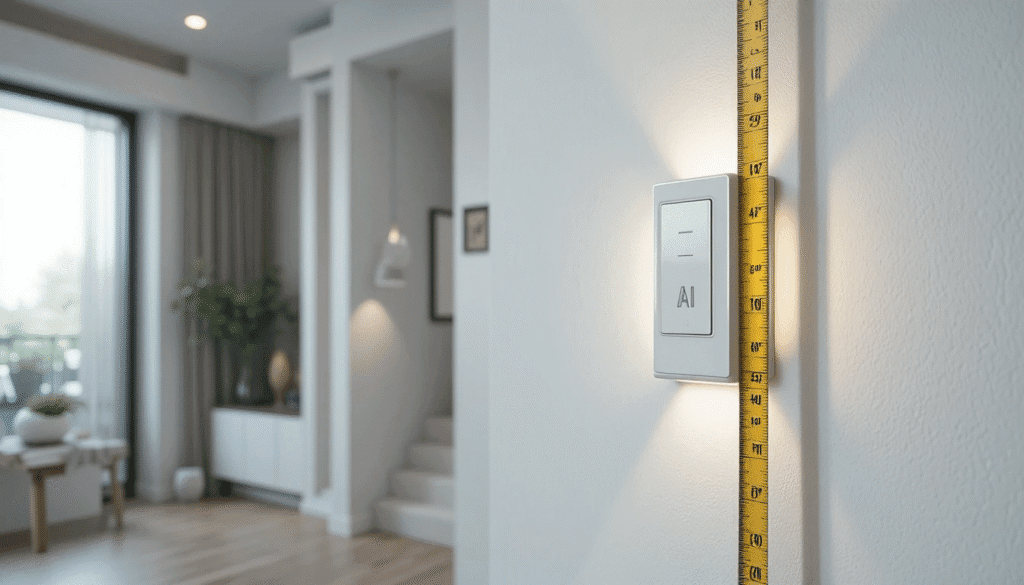Introduction
When planning or renovating your home, even small details like light switch placement can make a big difference in comfort, accessibility, and safety. One of the most common questions homeowners ask is: What is the standard light switch height?
In most modern homes across the U.S., the standard light switch height from the floor is about 48 inches (4 feet). But that’s not the whole story. Factors like ADA light switch height requirements, regional practices, cost, and even smart home technology can influence placement.
This guide will walk you through everything you need to know about residential switch height, including building codes, accessibility standards, and practical homeowner tips.
👉 Related: Standard Outlet Height Guide
What Is the Standard Light Switch Height?
The residential standard switch height is 48 inches (121 cm) above the finished floor. This height is widely adopted because:
- It’s convenient for most adults to reach without bending or stretching.
- It leaves enough clearance above baseboards and furniture.
- It aligns with electrical code switch height recommendations in many regions.
However, the National Electrical Code (NEC) itself does not strictly mandate an exact measurement. Instead, local building codes and accessibility requirements (like ADA) play a more important role.
Light Switch Height in Inches (Quick Facts)
- Standard residential switch height: 48 inches (4 feet)
- Lower range (custom installs): 42–44 inches
- ADA compliance range: 15–48 inches
- Above countertops (kitchens): 40–44 inches
- Children’s rooms/nurseries: 36–42 inches
👉 Related: DIY Wiring Basics for Homeowners
ADA Light Switch Height Requirements
For accessibility, the Americans with Disabilities Act (ADA) sets specific standards to make switches usable for people with mobility challenges.
- Switches should be no higher than 48 inches from the floor.
- In forward reach scenarios (like wheelchairs), the height may need to be lower (around 44 inches).
- For side reach access, the lower limit is 15 inches above floor level.
This means if you’re remodeling a home for accessibility, you might want to install switches closer to 42 inches rather than the standard 48.
💡 Tip: Always check your local electrical code since some states adopt stricter rules than ADA.
Light Switch Placement Guide (Room by Room)
| Room | Recommended Switch Height | Reason |
|---|---|---|
| Living Room | 48 inches | Standard reach for most adults |
| Kitchen | 40–44 inches above floor or counter | To clear countertop backsplash |
| Bathroom | 44–48 inches | Easy access when entering |
| Bedroom | 44–48 inches | Aligns with bed and door height |
| Children’s Room | 36–42 inches | Accessible for kids |
| Basement/Garage | 46–48 inches | Higher to avoid moisture/damage |
👉 Related: Home Renovation Tips for Beginners
Regional Differences in Standard Light Switch Height
While 48 inches is common in the U.S., different regions have slightly different standards:
- United States → 48 inches is the accepted norm.
- Canada → Similar to U.S., but some provinces allow 42–46 inches flexibility.
- United Kingdom → Switches are often placed higher, around 1200mm (47 inches), but accessibility standards sometimes prefer 42 inches.
- Australia → Many new builds adopt 1000–1100mm (39–43 inches) for convenience and safety.
👉 Related: Electrical Wiring Safety Tips
Electrical Code Switch Height Considerations
While the NEC doesn’t enforce an exact measurement, it provides guidelines to maintain:
- Consistency → Switches should be uniform across a floor to avoid confusion.
- Safety → Switches shouldn’t be blocked by cabinets, counters, or doors.
- Accessibility → Public buildings often follow stricter ADA height requirements.
Cost of Installing Light Switches
The cost of switch installation can vary depending on whether you hire an electrician or go DIY.
- DIY Installation
- Materials: $10–$20 per switch.
- Tools needed: screwdriver, voltage tester, wire stripper.
- Skill: Basic electrical knowledge required.
- Hiring an Electrician
- Labor: $75–$150 per switch (depending on complexity).
- Added safety and code compliance.
- Recommended for remodels or when adding new wiring.
👉 Related: DIY vs Professional Home Repairs
Smart Home Switches & Dimmers
With smart home adoption on the rise, switch height planning is slightly different.
- Smart Switches → Same height (around 48 inches), but require deeper wall boxes.
- Dimmers → Often placed at standard height but grouped with other switches for convenience.
- Voice-activated controls → Height becomes less critical, but ADA accessibility rules still apply.
💡 Pro Tip: If you’re planning a smart home system, group switches logically (e.g., near entry points) to avoid clutter.
👉 Related: Smart Home Devices Setup Guide
Standard Switch Height From Floor vs. Custom Installations
Some homeowners prefer custom light switch placement:
- Lower than standard (36–42 inches): For kids’ rooms or wheelchair accessibility.
- Higher than standard (50–52 inches): In garages or areas where switches need protection from damage.
As long as installations remain within local code requirements, small adjustments can make your home more functional.
Common Mistakes in Light Switch Placement
- Ignoring ADA standards → Creates accessibility issues later.
- Not aligning with outlet height → Inconsistent layouts look odd and confuse users.
- Installing too close to trim or corners → Switch plates may not fit properly.
- Overlooking future remodeling → Furniture or counters may block access later.
FAQs About Standard Light Switch Height
1. What is the standard light switch height in residential homes?
The standard residential switch height is around 48 inches from the floor, though some variation exists depending on room and local code.
2. What is the ADA light switch height requirement?
The ADA requires switches to be between 15 and 48 inches above the floor, ensuring accessibility for wheelchair users and people with limited mobility.
3. How high should light switches be above a countertop?
In kitchens and bathrooms, switches are often placed at 40–44 inches from the floor or just above the backsplash for convenience.
4. Is there an electrical code switch height rule?
The NEC does not mandate a fixed number, but most electricians follow the 48-inch standard for safety and uniformity. Always check your local building codes.
5. Can I customize my light switch height?
Yes, homeowners often adjust switch heights based on room design, accessibility needs, or personal comfort, as long as the placement follows local code.
6. How much does it cost to install or move a switch?
DIY costs about $20 per switch, while electricians may charge $100–$150 per switch depending on wiring complexity.
Optimized Visuals
- Diagram of Standard Light Switch Height
- Alt text: “Illustration showing standard residential light switch height at 48 inches above the floor.”
- ADA Accessibility Diagram
- Alt text: “ADA light switch height requirements range between 15 and 48 inches for wheelchair accessibility.”
- Kitchen Counter Switch Placement
- Alt text: “Light switch installed above kitchen countertop backsplash at 42 inches.”
Conclusion
The standard light switch height in most homes is 48 inches from the floor, but that doesn’t mean it’s always the right fit. Regional differences, accessibility requirements, and smart home upgrades can all influence the best placement.
✅ Action Step for Homeowners: Before finalizing your light switch installation, check local building codes, consider ADA requirements, and factor in future smart home needs. A little planning now ensures your home remains comfortable, safe, and future-ready.


